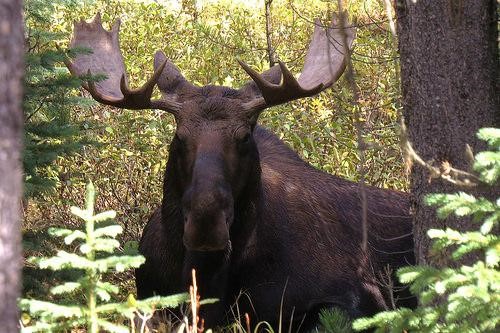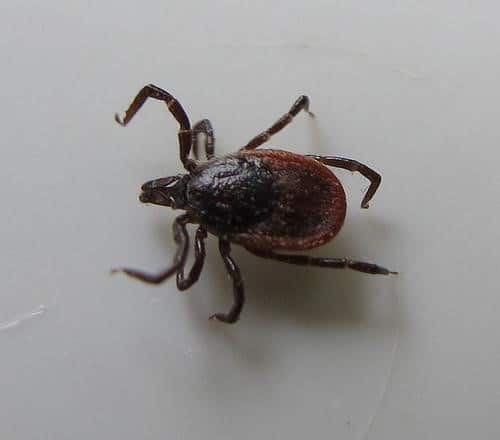Have you been seeing ghosts?
By: Jade Murphy
Published on May 17, 2017
The moose (Alces alces) is an important component of the boreal forest. Being a charismatic, mega fauna species, it helps to represent the lesser known critters that call the boreal forest home.
The moose’s gangly legs, awkwardly large palmate antlers, comically long snout, and dangling bell, come together to make a surprisingly majestic and noble creature. Being the largest of the deer species, it has few predators beside humans. It’s hard to imagine any creature that would be able to take on this regal mammal. It would have to be large, powerful, fast, and strong.
Or would it?

Allow me to introduce you to the winter tick (Dermacentor albipictus). This small, unmighty mite, reaching up to 15mm in size, is, believe it or not, a significant threat to the moose (“Moose Winter Tick,” 2012). These insects feed upon other animals, gorging themselves on their blood. Because ticks typically live and feed on their victims without killing them, they are considered parasites.
Unfortunately for the moose, it makes quite the hospitable tick host. This is because the moose is rather ineffective at grooming itself in comparison to other ungulates (Sine, Morris, & Knupp, 2009). When ticks first latch onto a moose, the moose doesn’t immediately react. It isn’t until the adult tick begins to feed, usually in February, that the moose becomes agitated and begins to extensively groom itself. Other ungulates, such as deer and elk, groom themselves in the fall and early winter, which helps to ensure that a large portion of tick larvae are removed before they manage to grow into blood-sucking adults (“Winter Tick in Moose,” n.d.).

Though small in size, the effects of ticks on moose can be substantial. A large enough infestation of ticks can cause significant blood loss, leading to chronic anemia, and subsequently, protein loss. Irritated, the moose rubs off thick chunks of their own fur in attempt to dislodge the ticks through licking, scratching, and rubbing. Moose suffering from significant tick infestations appear grey or white, as only their undercoat remains, and have been dubbed ghost moose. This loss of hair, actually called alopecia, combined with harsh winter weather, can lead to hypothermia (Sine, Morris, & Knupp, 2009). This compulsive grooming requires a lot of time and energy, resulting in overall poor condition and emaciation (“Moose Winter Tick,” 2012).
Typically, it is the calves that suffer the worst consequences of tick infestations (“Moose Winter Tick,” 2012).
However, moose and ticks have been coexisting for many years. A tick infestation does not necessarily mean a death sentence for a moose; moose can survive and flourish, despite winter tick infestations (“Ghost moose”, 2012). In fact, according to Parks Canada, the biggest declines in moose located in Jasper are attributed to wolf predation, liver flukes, and vehicular collisions on highways and railways (Wysong, 2015). Ticks didn’t even make the list!
That being said, if climate change trends continue, resulting in shorter winters and increased temperatures, it could mean serious consequences for moose. Milder winters make breeding easier for ticks, while also contributing to their overall survivability, consequently increasing their populations while subsequently reducing those of moose (Halsall, J, 2016).
This is just one more reason why it is important for us to conserve and preserve! Because what would Canada be without the moose, eh?

Sources
Wysong, P. (2015, October 16). Moose populations on alarming decline in parks. Retrieved from http://www.cbc.ca/news/technology/moose-documentary-1.3268868
Halsall, J. (2016, March 10). Booming winter tick populations have moose itching for colder winters. Retrieved from http://rabble.ca/blogs/bloggers/jenhalsall/2016/03/booming-winter-tick-populations-have-moose-itching-colder-winters
Moose Winter Tick. (2012). Retrieved from https://www.mffp.gouv.qc.ca/english/wildlife/wildlife-habitats/winter-tick.jsp
Sine, M., Morris, K., & Knupp, D. (2009). Assessment of a line transect field method to determine winter tick abundance on moose. Alces, 45, 143-146. Retrieved from file:///C:/Users/murph_000/Downloads/24-74-1-PB.pdf
Morse, S. C. (2012, March 13). Ghost moose: Winter ticks take their toll. Retrieved from http://northernwoodlands.org/articles/article/ghost-moose-winter-ticks-take-their-toll
Winter Tick in Moose and Other Ungulates. (n.d.). Retrieved from http://fr.cwhc-rcsf.ca/wildlife_health_topics/winter_tick/wintertick.php
Take Action
Share your support for National Urban Parks
Email your MLA to let them know you support National Urban Parks and would like to see Alberta be a part of a national network of urban parks.
STAY INFORMED
Protect the Wilderness
To receive news and updates from CPAWS Northern Alberta, including opportunities to get involved, join our mailing list below.
